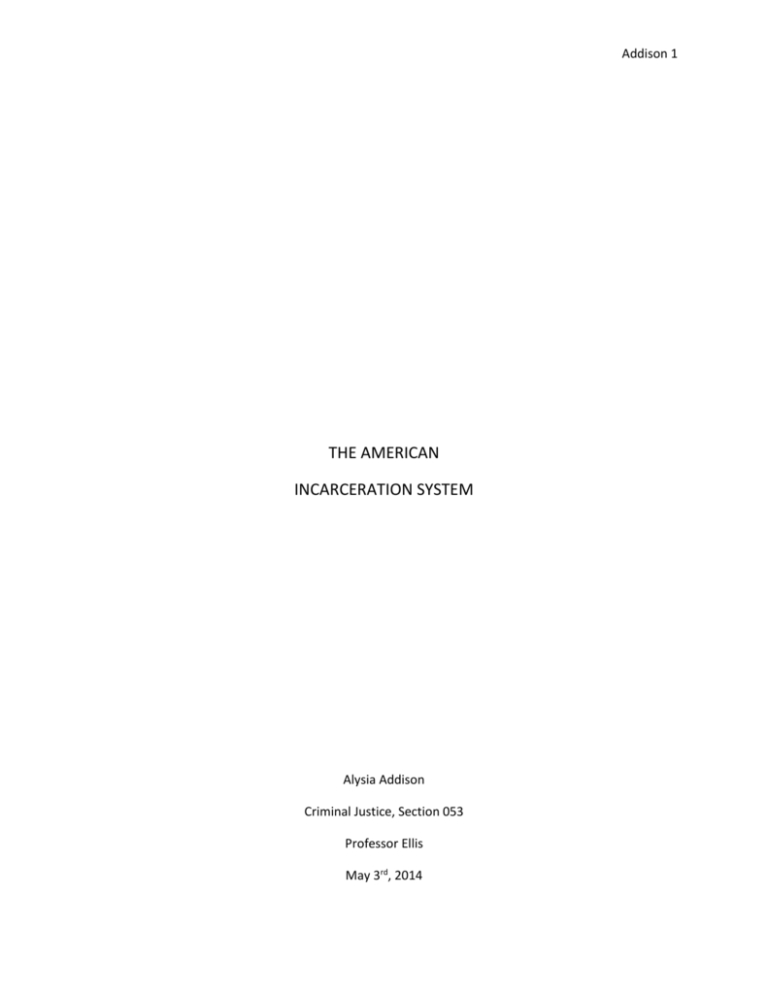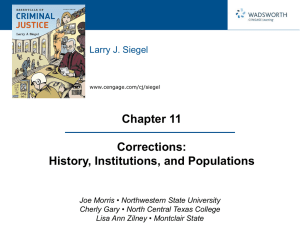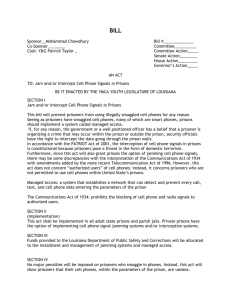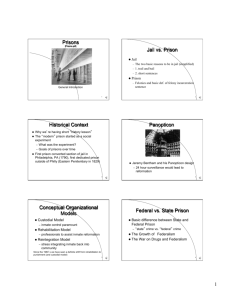The American Incarceration System - Alysia Addison E
advertisement

Addison 1 THE AMERICAN INCARCERATION SYSTEM Alysia Addison Criminal Justice, Section 053 Professor Ellis May 3rd, 2014 Addison 2 The history of America’s prison system is just as vast as our country’s history. There are so many practices that have changed, some have stayed the same. While most people think that jails and prisons go hand in hand, they are actually quite different. What are these differences, how is our incarceration system being run today, and why is the incarceration rate so high in the United States? The United States of America was founded on July 4th, 1776. The incarceration system in America began long before that, beginning with the discovery of the “New World” in the fifteenth century. The American prison systems were hardly the first. The earliest records of a prison were dated all the way back to 2050 – 1786 B.C. in Egypt. (Morris) Most of America’s prison system was modeled from their European counterparts, where most of our founders had immigrated from. America’s first jail was Philadelphia’s Walnut Street, opened in 1790. (Gaines) The penitentiary thought that labor and silence were the way to rehabilitation. This seemed to prevent idleness until the cost of running the penitentiary became too much. (Gaines) This was just the beginning of the American incarceration system and they found that things were not going the way they had planned. There were far too many prisoners and the costs that came with these prisoners were exponential. The Walnut Street penitentiary eventually succumbed to these issues and two new prisons were opened; The Western Penitentiary in Pittsburgh and Eastern Penitentiary in New York. (Gaines) While Walnut Street focused on labor and silence for rehabilitation, also known as the congregate system, the new prisons focused on obedience. Leading us to today’s rehabilitation tactics, the medical model. The medical model is “a model of corrections in which the psychological and biological roots of an inmate’s criminal behavior are identified and treated.” Daron Hall has defined jail as “a place for the confinement of persons in lawful detention.” For the most part, people are taken to jail, where they can be detained and watched, while they wait to be sentenced. 75% of people that are sent to jail are released with the first seventy-two hours. This is Addison 3 depicted in the graphic below. Some of these releases are due to overcrowding even though their sentence was supposed to be from 60-90 days. (Gaines) Fig. 1 Not only are people sent to jail to await trial, they are also there if they are serving time for a misdemeanor, a juvenile waiting for transferred to a detention center, and for housing inmates that will be transferred to prison. (Gaines) Unlike prison, jails do not have the resources for inmate rehabilitation. Most people are there to do their time, and then are released back into the general population. “Jails are operated on a county level by an elected Sheriff,” according to our text Criminal Justice in Action. The jail population on any given day is approximately 760,000 people in over 3,000 facilities across the United States. There are four different levels of jails classified as Mega, Large, Medium, and small. Each jail, respectively, holding 1,000 plus, 999 – 250, 249 – 50, and 49 – 1 inmates at any given time. Prisons have been defined by Mr. Hall as “lawful detention. Prison is a place convicted persons are confined.” People go to prison after they have been sentenced for a crime they have committed. While a majority of the jail population is released within 3 days, the prison population has an average sentence time of over 18,000 days as seen in the corresponding graph. Fig. 2 Addison 4 While jails are run on a county level, prisons are run on either a state or federal level, or privately owned as a business. There is a large controversy surrounding the privately owned prisons. These prisons are running as a business in order to make a profit. Not only do they cost less, but there is also less bureaucracy and more freedom in the way they run things. A lot of people are concerned about the safety and treatment of these prisoners. Privately owned prisons are only concerned about making money and not about rehabilitating the prisoner when they are returned to the “outside” world. (Gaines) Also, similar to jails, there are different levels of prisons: medium security, maximum security, and super-max security. Medium security prisons are definitely the most lenient. They house nonviolent offenders, people who have committed crimes such as embezzlement, and first time offenders. (Types) Many people have compared minimum security prisons to a country club because of the relaxed atmosphere and the lack of armed guards, also allowing the prisoners to leave the grounds for schooling or employment. (Gaines) While all of this seems unusual behavior for a prisoner, it is done in hopes of rehabilitating the prisoner. Thus, allowing them to make something of themselves when they are eventually released instead of being caught in the system. Medium security prisons are the next lenient type of prison facility. These facilities also have a more relaxed atmosphere when compared to high security. While this prison type is still relaxed, they implement numerous practices that prevent the inmate from escaping, such as high fences. They offer numerous programs for the prisoners to rehabilitate themselves and prepare to be released back into the outside world some day. They also allow the inmates to communicate and have friendships, instead of completely closing them off. (Gaines) Maximum security prisons are for people with repeat offenses and a history of violence. These prisons are designed to prevent anyone from escaping. They have 20-30 foot concrete walls that are burrowed deep in the ground to prevent tunneling. These types of prisons are run more like a military Addison 5 camp than the previous two. Everything they do is watched either by a security guard or on the surveillance system. They perform head counts and have watch towers to keep a constant eye on these violent offenders. (Gaines) These facilities offer very little in the rehabilitation department and their main goal is to keep the offender locked up. I believe the lack of rehabilitation programs is due to the fact that a majority of these prisoners will not be released any time soon. Super-max prisons are defined by The Encyclopedia of American Prisons as “the desire to modify the behavior of violent prisoners by what can only be entombing them in isolation cells for up to 23 hours a day – a practice instituted in the early 19th century in both the Pennsylvania and New York systems.” These facilities hold inmates that are known to commit murder inside the prison and are a complete danger to everyone. Super-max prisons are also home to convicted terrorists. They believe that by keeping them locked away in complete isolation will prevent them from acting out in any way until they are executed or pass away. Unlike other prison styles, there is no inmate contact whatsoever and they do everything inside of their cells, with the exception of an hour break. (Gaines) The cost of these institutions is astronomical. There is a 1/1 prisoner to guard ratio, sometimes even more guards than there are prisoners, leading to highly increasing salaries due to all the overtime that has to be paid. According to the U.S. Bureau of Justice Statistics, at least 2.5 million people have been incarcerated per year, since 2011. This number keeps drastically increasing. Many people have attributed this to the sharp incline in minor drug related charges and the high number of repeat offenders who can’t get out of the system. Addison 6 “The number of drug offenders in state prisons has increased thirteen-fold since 1980” according The Sentencing Project. Most of the people who are arrested for drug charges are only carrying a small amount of drugs and have no history of criminal behavior or any violent behavior. (Sentencing) These types of criminals are taking over our prison population, making their little or no room for violent offenders who are an actual harm to society. The violent offenders are then released because there is no room for them due to overcrowding. (Gaines) In my opinion, we really need to reform our prison system. Keep the prisons open for violent offenders and people who are a harm to society. In doing this, we need to have more systems for drug offenders and addicts. If we have more services to help people get off of drugs and less harsher sentences, we can dramatically decrease the prison population and leave room for people who actually need to be there. While America’s prison system is very organized, especially in contrast to other parts of the world, there are still an abundant amount of issues that need to be fixed. The high cost of running the prisons is astronomical and a new system needs to be put into place. After looking back at the prisons and jails history, so many things have changed. If they keep implementing new changes, chances are they will find a system that works. Addison 7 WORKS CITED Broyles, Beth. "Tamms Supermax: Report Reveals More Guards Than Prisoners, Soaring Costs - Solitary Watch." Solitary Watch. N.p., 4 Dec. 2012. Web. 28 Apr. 2014. <http://solitarywatch.com/2012/12/04/tamms-supermax-report-reveals-more-guards-thanprisoners-soaring-costs/>. Fig. 1 Percent of Inmates Remaining in Jail by Days. http://www.caselaw.org/Secondary%20Pages/AverageLengthOfStay.html 2007. Fig. 2 Incarceration Trend Total Prison Days Sentenced. http://www.justice.gov/atr/public/division-update/2012/criminal-program.html Gaines, Larry, and Roger Miller. “Prisons and Jails.” Criminal Justice in Action. Mason: Cengage Learning, 2012. Print. Hall, Daron. "Jails vs. Prisons." Corrections Comendium (): 1. Print. Morris, Norval. The Oxford History of the Prison: The Practice of Punishment in Western Society. New York: Oxford University Press, 1998. Print. Sifakis, Carl. The encyclopedia of American prisons. New York: Facts on File, 2003. Print. "Statistics of Note." American Jail Association. N.p., 1 Jan. 2014. Web. 27 Apr. 2014. <https://members.aja.org/About/StatisticsOfNote.aspx>. Addison 8 "The Sentencing Project News - Drug Policy." The Sentencing Project News - Drug Policy. N.p., n.d. Web. 28 Apr. 2014. <http://www.sentencingproject.org/template/page.cfm?id=128>. "Types of Prisons." Crime Library. National Museum of Crime & Punishment, n.d. Web. 28 Apr. 2014. <http://www.crimemuseum.org/crime-library/types-of-prisons>.








